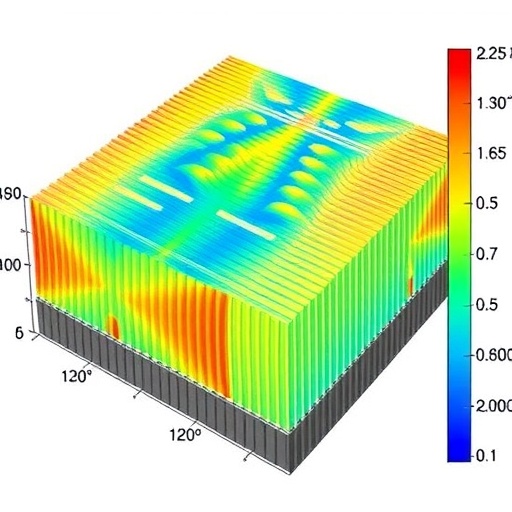In a remarkable breakthrough that promises to redefine the future of thermal management technologies, researchers at the Queensland University of Technology (QUT) have uncovered the secret behind why certain materials exhibit extraordinarily low thermal conductivity despite compositional irregularities. This discovery, revealed through meticulous experimentation and cutting-edge microscopy, unravels the longstanding puzzle of how structural defects at the atomic scale influence heat transport in thermoelectric materials, providing a transformative blueprint for engineering next-generation energy conversion and insulation systems.
Harnessing the power of advanced electron microscopy and scanning thermal probe methodologies, the research team delved into the atomic architecture of the bismuth-antimony-telluride alloy, a paradigmatic thermoelectric material widely employed for its ability to convert waste heat into electrical energy. Their detailed analysis illuminated previously overlooked microstructural phenomena, focusing in particular on the distribution and alignment of edge dislocations—minute defects traditionally considered mere imperfections but now revealed as crucial modulating agents of phonon scattering and thermal resistance.
Conventional wisdom posited that the thermal conductivity of heterogeneous materials was primarily dictated by the nature and scale of their compositional mixing. However, the QUT team’s findings challenge this narrative, demonstrating that the random spatial arrangement of edge dislocations plays a far more pivotal role in impeding heat flow. These dislocations, scattered in disordered orientations throughout the uneven matrix, act as formidable barriers that disrupt the smooth propagation of phonons—the primary heat carriers in non-metallic solids—thus dramatically suppressing thermal conduction.
By systematically comparing samples with varying degrees of compositional ordering, the researchers observed a striking correlation: materials exhibiting greater randomness in the distribution of bismuth- and antimony-rich domains consistently manifested lower thermal conductivity values. This phenomenon cannot be solely attributed to compositional disparity but is intricately linked to the scattering effects induced by the erratic alignments of dislocation lines. The team’s innovative approach to visualizing and quantifying these defects at such an unprecedented resolution has opened an entirely new dimension in materials science.
The implications of this discovery transcend academic curiosity, heralding tangible advancements for industrial applications where thermal management is paramount. From the optimization of thermoelectric generators—devices that convert heat differentials directly into usable electricity—to the enhancement of thermal insulation materials designed to conserve energy in buildings and aerospace technology, the ability to precisely engineer defect landscapes could revolutionize performance metrics and energy efficiencies.
Leading the project, Professor Zhi-Gang Chen highlighted that this newfound understanding not only enriches the fundamental physics of heat transport but also establishes actionable design principles for fabricating materials with tailor-made thermal properties. By manipulating the formation processes and spatial arrangements of edge dislocations, materials scientists can now strategically attenuate thermal conductivity while preserving other crucial mechanical and electrical characteristics, a feat that was elusive under traditional defect engineering paradigms.
First author Siqi Liu emphasized that this structural insight reframes the design philosophy of thermoelectric materials, shifting attention from mere compositional engineering to the orchestration of microstructural inhomogeneities at the nanoscale. “Our work illustrates that it is not just the materials’ composition but the geometric and statistical configuration of their defects that governs thermal behavior,” Liu explained. “This paradigm shift opens a new target for controlling heat flow with atomic precision.”
The study’s success was borne out of the integration of sophisticated experimental techniques capable of probing local chemical and thermal variations with atomic fidelity. Scanning thermal probes mapped heat flow with exquisite spatial resolution, while electron microscopy unveiled the arrangement of various compositional domains and their associated dislocations, enabling a comprehensive correlation between structure and thermal transport phenomena.
Moreover, the findings resonate across a spectrum of scientific disciplines and industries, promising to influence the development of novel materials beyond thermoelectrics. For instance, the ability to modulate heat conduction via controlled defect alignment could inspire breakthroughs in thermal barrier coatings, semiconductor device cooling, and even gas storage materials where thermal management influences storage efficiency and safety.
With the release of their comprehensive research article titled “Alignment of edge dislocations – the reason lying behind composition inhomogeneity induced low thermal conductivity,” published in Nature Communications, the QUT team invites the scientific community to explore the manifold applications and theoretical interpretations of their discovery. This work stands as a testament to the power of combining atomic-scale imaging with thermal characterization to solve complex material science challenges.
Looking forward, the team is committed to extending these insights by experimenting with alternative compounds and synthesis methods to refine control over dislocation patterns. Such endeavors aim to unlock new classes of materials that optimize energy conversion processes, reduce environmental footprints, and enhance the sustainability of future technologies.
In sum, the identification of randomly aligned edge dislocations as a fundamental structural mechanism driving low thermal conductivity reshapes our understanding of heat transport in compositionally inhomogeneous materials. This breakthrough not only enriches scientific knowledge but equips engineers and designers with novel strategies to tune thermal properties, paving the way for innovations that could profoundly impact energy harvesting and thermal management technologies worldwide.
Subject of Research: Not applicable
Article Title: Alignment of edge dislocations – the reason lying behind composition inhomogeneity induced low thermal conductivity
News Publication Date: 5-Nov-2025
Web References:
https://doi.org/10.1038/s41467-025-64749-5
References:
Liu, S., Liu, W-D., Lyu, W., Yue, Y., Gao, H., Li, M., Shi, X-L., Chen, Z-G. (2025). Alignment of edge dislocations – the reason lying behind composition inhomogeneity induced low thermal conductivity. Nature Communications. https://doi.org/10.1038/s41467-025-64749-5
Image Credits: QUT
Keywords
Electricity, Thermoelectricity, Energy
Tags: advanced electron microscopy applicationsatomic scale heat transportbismuth-antimony-telluride alloyedge dislocations in materials scienceenergy conversion systemsinsulation system engineeringlow thermal conductivity in materialsphonon scattering mechanismsQueensland University of Technology researchstructural defects in thermoelectric materialsthermal management technologiesthermal resistance in materials





